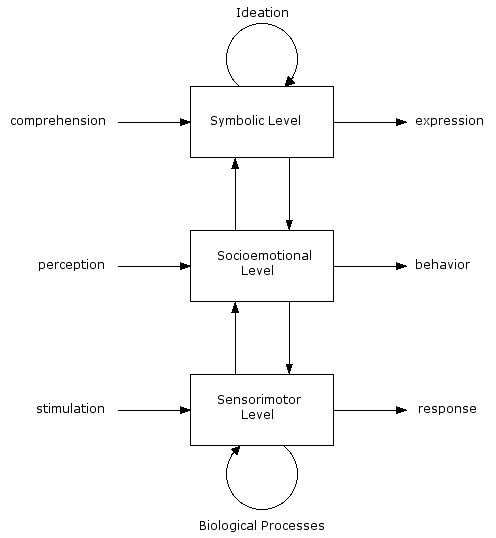The Three Levels of the Mind
C. George Boeree
We are complex creatures and often seem to function at several levels simultaneously. Sometimes the results are astounding -- such as when a sculptor creates or a footballer scores. Sometimes the levels conflict and confound each other -- such as when we fall on our faces while daydreaming of a lover. Either way, it helps us understand ourselves if we consider ourselves as mentally multilayered. I think that there is a good case to be made for the existence of three levels of the mind, the sensorimotor, the socioemotional, and the symbolic, arranged as in this diagram:

- Ideation: Thought and imagination at the formal operations level. It is an extension or emergent aspect of the symbolic level.
- The symbolic level: Linguistic processes; Thought and imagination at the concrete operations level; Beliefs and techniques (i.e. "memes").
- Socioemotional level: Social perception and behavior; Social instincts and social learning; Imitation, conformity, obedience; The preoperational level; Emotions beyond simple pain and pleasure.
- Sensorimotor level: Reflexes, drives, basic instincts, pain and pleasure, plus conditioning. It is the first psychological extension of our biological processes.
- Biological processes: Non-mental processes.
The temptation is to view the "higher" levels as somehow "better." But that is not necessarily true: Cognition, for example, is only indirectly linked to the lowest levels, and is "out of touch" with our nature. Like a body-less angel, it is not fully human. We talk about the "angel" aspect of ourselves (our philosophical or spiritual side) and the "beast" aspect of ourselves (our biology), but we should really talk even more about what holds them together -- the socioemotional aspect. As Vonnegut suggested, maybe we need more (and better) social instincts, not less!
Although these levels were arrived at independently, the resemblance to the triune brain idea is obvious:
- Sensorimotor level -- Reptilian brain (roughly, the brain stem)
- Socioemotional level -- Paleomammalian brain (roughly, the limbic system)
- Symbolic level -- Neomammalian brain (roughly, the cerebral cortex)
